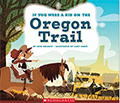|
|
|
|
|
|
 |
End of the Oregon Trail Interpretive Center - Step back into the 1840’s, where kids can try on pioneer bonnets and skirts or shirts and pants, grind wheat for flour, pack a covered wagon with flour, salt and sugar, sit in an outhouse, play with old-fashioned wooden toys and games, get a land certificate, sit on benches to read a McGuffey’s reader or practice writing. A 30 min. movie, Bound for Oregon, is a good introduction to life on the Oregon Trail. Take the scavenger hunt to look for a prairie schooner, Dutch oven, butter churn, wagon wheel and washtub. Outside, wander through the Heritage Garden, check out the official “End of the Trail” markers, watch demonstrations of log splitting and cabin building. There are picnic tables under the trees, bring your lunch. |
|
|
|
|
| |
|
|
Tip: Amtrak has a train stop, right across from the Interpretive Center. If you’re taking the train, you could get off here, stay over night and get on the train the next day. |
|
|
|
|
| |
|
 |
Baker Cabin (Carver) – To continue your explorations of the Oregon Trail, head east on Clackamas River Dr. to Carver (this is about 8 miles). Visit the hand-hewn log cabin of Horace and Jane Baker. The Bakers came west on the Oregon Trail in 1846, claimed their land and settled here. The cabin, built in 1856, is constructed without nails, inside is a huge stone fireplace for cooking, outside a well and pump for water. The grounds are open year round. |
|
|
|
|
| |
|
 |
Philip Foster Farm (Eagle Creek) –The Foster Farm was a stopping off point for pioneers at the end of their journey on the Oregon Trail. Philip Foster operated a store on the farm, had meals and rented cabins to immigrants. Today, see a complete replica of his store (fully stocked), hand-hewn log cabin, barn and farmhouse, vegetable garden and pumpkin patch. You can wander around the farm year round, dawn to dusk. To see inside the farm buildings, they are open June to September. There are also annual events, such as barn dances, a “cider squeeze,” and Christmas celebrations. |
|
|
|
|
 |
 |
|
|
|
|
|
|
|
|
| |
|
|
 |
|
It's spring 1845, meet Stephen and Josephine, starting out on 2,000 mile Oregon Trail, walking or riding a horse, helping with many chores, crossing vast plains, arriving in Oregon City. Plus fun facts – each night the settlers camped in wilderness, traveling without doctors or medicine, trading for supplies from Native Americans, and timeline. (Picture book)
|
|
|
|
|
|
| |
|
|
|
Ranger is a golden retriever search and rescue dog, who time travels to 1850, and joins Sam Abbott and his family heading west on the Oregon Trail. Plenty of dangers along the way, and Ranger is there to help. (Chapter book)
|
|
|
|
|
|
|
|
|
|
|
|
| |
|
|
 |
|
It's 1843, ride with great-great-great-great grandmother Elizabeth in a crowded wagon on the bumpy trail west, eating cold beans and biscuits, walking in mud and rain, scaling snow covered mountains to reach Oregon City (Portland). (Picture book)
|
|
|
|
|
|
| |
|
|
|
Kate Purdy and her family are going west and it's a tough journey. When Kate finds an orphan cat, she names her Snuggs, and hides the little cat in their wagon. Upon reaching Oregon, turns out cats are in high demand. (Easy reader)
|
|
|
|
|
|
|
|
|
|
|
|
| |
|
|
 |
|
Pictorial history of journeys west, including the Oregon Trail – pioneer children and daily life, Native American culture, firsthand accounts, plus 21 activities – make cornbread, maple snow candy, and apple butter, build a little log cabin, churn your own butter, dip candles, and more. Excellent historical illustrations, good for older kids. (Activity book)
|
|
|
|
|
|
| |
|
|
|
Did you know you can still see wagon tracks on parts of the Oregon Trail? Go west across the United States, with fascinating facts, early explorers, pioneers and 25 activities, write a treaty or diary, map locations on the Oregon Trail, pack for the trip, make moccasins, and more. Good for older kids. (Activity book)
|
|
|
|









